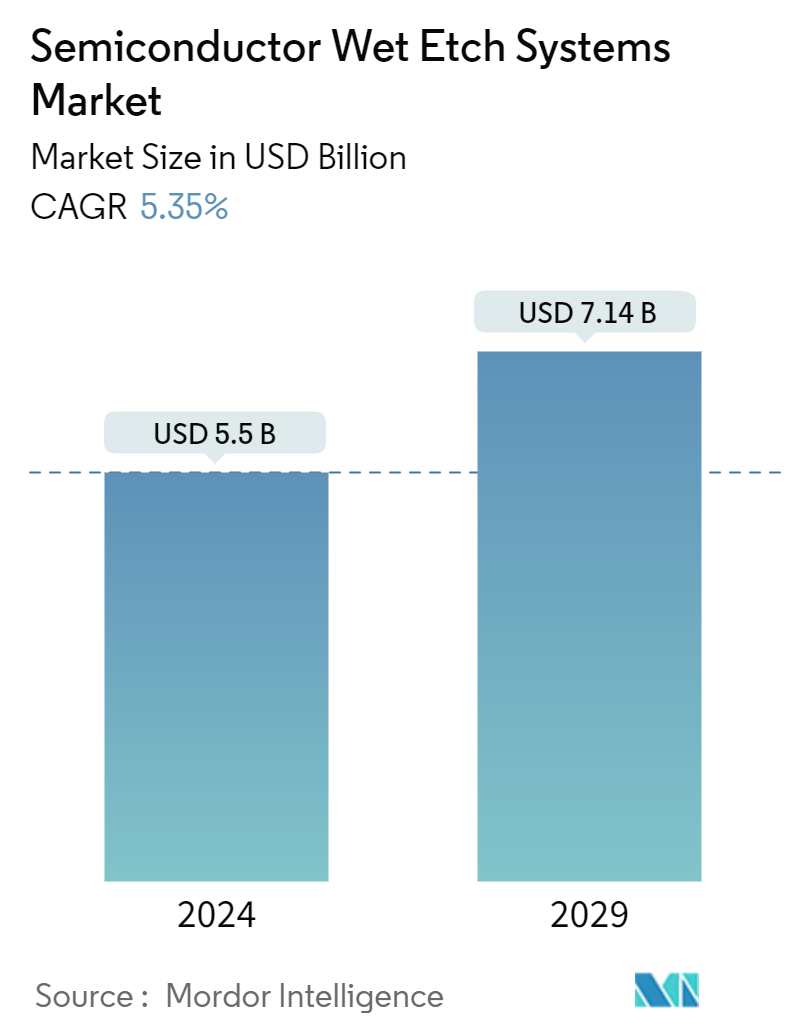Market Size of Semiconductor Wet Etch Systems Industry

| Study Period | 2019 - 2029 |
| Market Size (2024) | USD 5.5 Billion |
| Market Size (2029) | USD 7.14 Billion |
| CAGR (2024 - 2029) | 5.35 % |
| Fastest Growing Market | Asia Pacific |
| Largest Market | Asia Pacific |
| Market Concentration | Medium |
Major Players*Disclaimer: Major Players sorted in no particular order |
Semiconductor Wet Etch Systems Market Analysis
The Semiconductor Wet Etch Systems Market size is estimated at USD 5.5 billion in 2024, and is expected to reach USD 7.14 billion by 2029, growing at a CAGR of 5.35% during the forecast period (2024-2029).
Recognizing the strategic significance of semiconductors, governments across the world are prioritizing them for economic competitiveness and supply-chain resilience. The global chip shortage, a fallout from the recent crisis, highlighted how vulnerabilities in the semiconductor supply chain jeopardize technologies and products integral to daily life.
- Despite being developed, countries like the United States are susceptible to supply-chain disruptions. This vulnerability stems from their delayed support for the semiconductor sector, a domain where other nations have long recognized its strategic importance and provided fiscal backing. Heightened geopolitical tensions have intensified the urgency for some governments to fortify their positions in the global chip supply chain.
- As a case in point, the United States has unveiled an ambitious USD 52 billion initiative aimed at rejuvenating its chip manufacturing and research landscape. Globally, governments are reassessing their roles in the semiconductor value chain, formulating national industrial policies, and channeling substantial investments into domestic semiconductor manufacturing and R&D. Over the past few years, major players in the semiconductor arena, including China, Korea, and the EU, have collectively signaled potential government investments of around USD 250 billion over the next decade, all earmarked for the semiconductor industry. Such dynamics have catalyzed a pronounced increase in the global demand for front-end equipment, notably wet etch systems.
- Wet etch systems, pivotal in semiconductor fabrication, are instrumental in producing diverse devices, from microprocessors and memory chips to sensors. Consequently, heightened investments in chip fabrication are creating substantial opportunities in the market. With fabs poised to mitigate the ongoing semiconductor chip shortage, countries are witnessing a notable surge in investments. For instance, in January 2024, Tata Group revealed its intentions to establish a semiconductor fabrication plant in Gujarat, India, and is on the brink of announcing a significant fab in Dholera, Gujarat. Hence, such trends also create a favorable ecosystem for the studied market's growth.
- Additionally, integrated device manufacturers (IDMs) play a pivotal role, making substantial investments in wafer fabrication capacities. A testament to this is the June 2023 collaboration between Intel and the German government, which culminated in a revised letter of intent for a state-of-the-art wafer fabrication site in Magdeburg, backed by an investment exceeding EUR 30 billion for two pioneering semiconductor facilities in Europe. Similarly, in July 2023, Samsung committed USD 17 billion for a semiconductor fabrication plant on a sprawling 1,200-acre site in Austin, Texas. This strategic move comes as geopolitical strains between China and Taiwan have nudged chipmakers toward manufacturing in the United States, with Texas standing out due to its favorable tax environment and fresh subsidies.
- The factors driving the semiconductor wet etch systems market are increasing demand for semiconductors, technological innovations, and the rising embrace of advanced packaging technologies. Moreover, the escalating quest for sustainable energy is propelling the solar technology market, particularly boosting the demand for crystalline silicon PV cells. As the market for crystalline silicon solar cells expands, so does the need for wet etch systems. This is because wet anisotropic etching is crucial for the surface texturing of these solar cells, a process that minimizes light reflection and enhances productivity.
- The market continues to face challenges, such as the shift from wet etching to dry etching in certain emerging products and technologies within the electronics sector, which restrain the semiconductor wet etch system market's growth. Furthermore, with the wet etching process consuming significantly higher amounts of chemicals that are usually harmful to humans and the environment, the focus of the semiconductor industry toward sustainable manufacturing will also challenge the market's growth during the forecast period.

